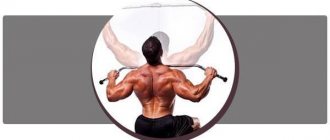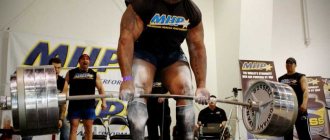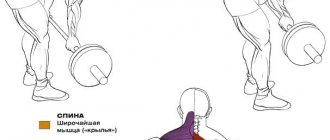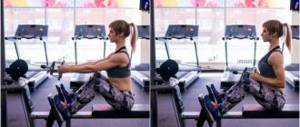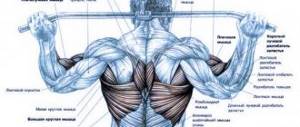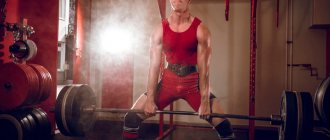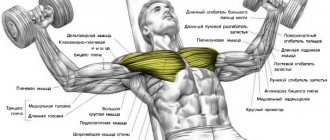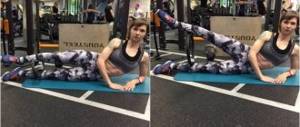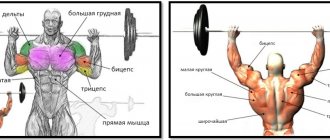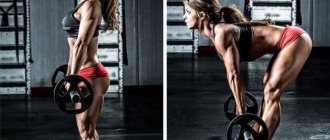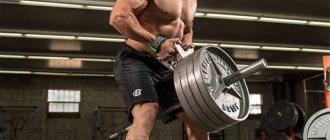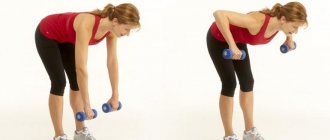Author: Timko Ilya - the ruler of the entire site and fitness trainer | more details >> Rod. 1984 Trained since 1999 Trained since 2007. Author and creator of the site tvoytrener.com. CCM in powerlifting. Champion of Russia and South Russia according to AWPC. Champion of the Krasnodar region according to IPF. 1st category in weightlifting. 2-time winner of the Krasnodar Territory championship in t/a. Author of more than 700 articles on fitness and amateur athletics. Author and co-author of 5 books.
Place in the author rating:
out of competition
(become an author) Date: 2012-05-29 Views: 1,783,516 Rating: 4.9
| All articles by the author >> | Medals articles >> |
Articles are loading...
| Article medals: | article in TOP 50 | more than 1 million views |
Why medals are given to articles:
| Bronze medal: | |
| 1. The article is in the TOP 100 2. The article has more than 3. The article has more than 100 | |
| Silver medal: | |
| 1. The article is in the TOP 50 2. The article has more than 3. The article has more than 500 | |
| Gold medal: | |
| 1. The article is in the TOP 10 2. The article has more than 1 3. The article has more than 1,000 | |
Primary muscles - latissimus Additional - biceps, rear deltoid, teres major and rhomboids Difficulty - medium
The technique is performed only in the gym on a special simulator
The overhead pull-down is suitable for expanding the size of the torso due to the growth (hypertrophy) of the latissimus muscles. Simulates standard pull-ups, as it works a large number of muscles. However, it has its advantages compared to pull-ups.
On the simulator, you can adjust the weight and exercise in a descending pattern, even for beginners, that is, gradually increase the load. This allows you to make a larger range of motion and, accordingly, better work out the torso.
Advantages:
- Increasing the width of the back.
- V-shaped torso and thin waist.
- Smooth posture.
- Muscular and sculpted torso.
- Availability and ease of implementation.
- Suitable for those who cannot do pull-ups.
- Suitable for beginners.
- Suitable for men and women.
Unlike the front row, which targets the rhomboids and increases their thickness, the overhead row increases the width of the muscles.
How to start classes correctly
It is recommended to perform the exercises in the first part of the workout in the gym. To begin with, you need to choose the right weight (block weight) and number of repetitions. For this, it is better for beginners to contact an instructor.
Weight is determined by the level of physical fitness and the goals of the bodybuilder (to lose weight, build muscle mass, to “dry” the body). Beginners first need to work out the technique correctly, so it is better to start training with minimal weight.
It is necessary to start with 10 repetitions of 2 - 3 sets with weights of 25 - 30 kg for men and 15 - 20 kg for women . It is advisable for athletes with little experience to do 12 times for 4 approaches, for athletes with experience - 15 times for 4 approaches.
The main thing when performing an exercise is to adhere to the quality of the exercises, and not their quantity. To “dry”, gradually increase the weight or number of repetitions.
Before each session, be sure to do a warm-up (cardio exercise on an exercise bike, squats, bends, exercises with dumbbells) to warm up your muscles and prepare them for a safe and effective workout. At the end of the session, you need to relax the working muscles by stretching.
Before training, it is recommended to drink a glass of water (green tea), and during training, drink a little every 15-20 minutes. To increase muscle mass, you need to eat protein (powdered protein drinks, lean poultry or fish, egg whites) and carbohydrate foods (rice, oatmeal, wholemeal bread, freshly squeezed fruit juices diluted with water) in the first 20 minutes after training.
Almost eliminate fat from the diet. It is not recommended to eat food 1-2 hours before training.
Execution technique
The overhead pull-down is an exercise whose technique requires skill that is developed with light weight. The correct technique allows you to work exactly those muscle groups for which the exercise is intended.
If there are errors in technique, other muscle groups are involved in lifting the weight, which reduces the load on the target muscle and reduces the effectiveness of training. The main “chips” of execution:
- Sit facing the machine, fix your hips under the bolsters. Adjust the desired height.
- The angle between the shin and thigh should be 90°, with the feet flat on the floor.
- The back is straight in a natural position with a deflection in the lower back, the gaze is directed forward.
- Take the bar of the upper block with both hands with a wide grip - grab it as wide as possible.
- As you inhale, carefully and smoothly pull the bar behind your neck to the level of the back of your head (ear level).
- Try to bring your elbows closer to your body, bringing your shoulder blades together. Pull with your shoulder blades together, not with your hands.
- At the same pace, return your hands to their original position and exhale. Feel the muscle stretch at the top.
If you are working out with a coach or friend, he can help you push the handle and pick it up at the end of the exercise (at the top point). If you are working out with a lot of weight, you can ask someone to help you pick up the block at the end.
Start with 4 sets of 12 reps. Use a lighter weight to practice your technique. When training for mass, do 4 sets of 10-12 repetitions, increasing the weight with each approach. When cutting - 4-5 sets of 15-20 repetitions with a lower initial weight, increasing the weight or number of repetitions with each approach.
Classic lat pulldown
Main stages of correct execution:
- Correct placement in the machine. First, adjust the roller that secures the legs (knees) so that the weight does not pull the body upward. Place your hips tightly under the bolsters, and press your feet to the floor at knee level. Place the pelvis on the seat so that the upper block with the bar is above your head.
- Grab the handle of the bar with your hands. Having taken the correct position on the machine, as you exhale, pull the bar down, moving it behind your head. The narrower the grip, the more the biceps are worked (which in this case is not desirable), and the range of movements increases. On the contrary, as the grip increases, the load on the back increases and the amplitude decreases. It is optimal to choose a medium grip. There are scars on the handle on the right and left, you need to grab it so that your little finger is at the beginning of the scar - this is approximately an average grip. When bending your elbows at the lowest point at an angle of 90°, your forearms should be perpendicular to the floor and parallel to each other. The training cable is placed in a vertical position.
- When performing the exercise, fix your body exactly in a vertical position and do not slouch, tilt your head slightly forward, but look straight. In this case, the forearms move along the body, the shoulder blades are brought together. Pull the bar only by working your back muscles, not your arms! If during the movement the shoulders and forearms tense, and not the back (latissimus, rhomboid and lower trapezius muscles), then the execution is incorrect. If, despite the correct technique, the back is not being worked out, it is necessary to reduce the weight.
- You need to pull the bar until you lightly touch the back of your head. Then pause at the bottom point for a few seconds and straighten your elbows at the top point and inhale, but do not completely relax the shoulder girdle. You should not stretch your back and shoulders too much; this can lead to sprains and injuries. At the end of the workout, when the elbows are extended at the top point, take a series of inhalations and exhalations.
For a harmonious physique and athletic torso, it is recommended to systematically perform lat pulldowns 2-3 times a week.
Features of the technology:
- If, due to poor mobility of the shoulder joints, it is impossible to perform this exercise without slouching, it is better to abandon it.
- When moving your arms down, you need to lean forward slightly and bring your shoulder blades together.
- You need to pull the bar to the middle of the back of your head. To reduce excess load on the forearms, you can secure your hands to the bar with straps.
- Keep your head straight and look forward. The back is straight.
Complicated options and trajectories
The difference in grip of the handle distributes the load on different muscles.
There are three options for gripping the bar:
- straight (brushes turned away from you)
- reverse (the hands are turned towards you)
- parallel (the forearms are parallel and the hands are turned towards each other).
Straight-grip, wide-grip rows work the latissimus and teres major muscles while stretching ligaments and connective tissues. With a narrower grip, the load falls on the trapezius, biceps, lower part of the latissimus and posterior deltoid muscles. The close-grip row can be performed in a reverse or straight version.
When pulling a block with a reverse grip, the biceps are worked more. The parallel grip is a simplified version of the overhead pull-down and is best suited for beginners. If you have mastered and easily performed all the variations of exercises with the upper block, then you can move on to pull-ups on the bar.
Varying grip width
The width of the grip with which pulleys are performed behind the head while sitting is an important nuance that allows you to work out the muscles in more detail.
The exercise is performed with the following grips:
- straight;
- back;
- wide;
- medium (neutral);
- narrow.
With a reverse grip, the hands are turned with the thumbs outward. A narrow reverse grip increases the load on the latissimus muscle bundles closest to the spine, which increases their relief. The trapezius and posterior deltoid muscle bundles are also affected.
Girls are recommended to perform exercises with a medium or narrow grip to obtain a more pronounced transition line of the back and waist. The lateral parts of the spinal muscles are worked by pulling the upper block behind the head with a wide grip.
This technique helps to gain muscle volume and emphasize the load on the latissimus muscles, and partly on the teres major, while simultaneously stretching the ligaments. With this method of performing the exercise, the load is distributed over a large area of muscle tissue.
You can get acquainted with the technique of performing the exercise for girls using this video:
Comprehensive muscle strengthening program
To effectively and efficiently work out all three groups of spinal muscles, overhead pull-downs are combined with other basic strength exercises:
- longitudinal press;
- bent over T-bar pull;
- lifting weights in a bent position with pauses;
- pulling dumbbells to the belt;
- pullovers;
- vertical lifting of weights with one hand;
- Pull-ups on the bar.
It is not necessary to do all the exercises at once; it is enough to alternate several of them 2-3 times a week.
Female representatives, depending on their goals, can work both on strength indicators for the relief of the body, and on “drying” the upper back and shoulder girdle. Since girls find it difficult to do classic pull-ups on a bar, this exercise will help achieve a beautiful back shape.
Block pull behind the head and to the chest
These two exercises differ in that they are performed differently and affect the back muscles. Naturally, when the position of the handle changes, the muscles work slightly differently. It is generally accepted that pulling to the chest affects the width of the back, and pulling behind the head affects its thickness.
And if we talk about detailing the muscles, then... to be honest, I don’t know what will happen. Try it, at least it won't get any worse. Let me know in the comments if you decide to try experimenting.
Pulling weight
Achieving your goal depends on your weight. The weight should be small (about 50% of the maximum), if your task, dear girls, is to make yourself more beautiful. If stronger, then increase it to 70 - 75%. The number of approaches and repetitions varies depending on the weight. When it’s small, it’s a lot; when it’s big, it’s less.
Dear girls, pay your attention to the training course of Yuri Spasokukotsky, which is specially designed for the fair half of humanity. The course is called "".
The vertical pull-down can be a great way for girls to achieve their goals. As you can see, you can work on strength, endurance, relief and mass. The range of influence of the exercise is large, and its potential is inexhaustible.
If you liked the article, be sure to tell your friends about it through social networks, and also subscribe to blog updates. I wish everyone a pleasant training. Bye.
Basic rules for completing a workout
To prevent soreness caused by the accumulation of lactic acid in the muscles after exercise, you must adhere to the following recommendations:
- Every time before training, do a warm-up, and then stretch: standing straight, bend your chest forward, move your pelvis back. Bend your back at the thoracic region, then bend it back as far as possible. Bring your shoulders forward, stretch your arms forward and down. Move your chin following your hands. Stretch your arms as far as possible and return to the starting position. The tension should be felt in the area of the shoulder blades.
- End each workout with aerobic exercise (10 minutes on an exercise bike or treadmill).
- After each approach, take a break for 30 seconds.
Contraindications and restrictions for training
There are virtually no contraindications for overhead pull-downs, with the exception of:
- Hernia of the spine in the thoracic region.
- Injuries (sprains, dislocations, fractures) of the shoulder girdle, hands, elbows, back.
Don't miss the most popular article in the section: Morning exercises for those over 40, 50. Gymnastics exercises for weight loss, video lessons.
Basic errors during execution
Common mistakes:
- Stooping (curvature of the spine).
- Lifting the buttocks from the seat.
- Full extension of the forearms at the top point.
- Redistributing the load on the biceps of the arms, rather than the body.
- Too much weight or a large number of approaches, which will make it difficult to perform the exercise correctly.
If you don't straighten your back when performing overhead pull-downs, you may get injured.
Consequences of incorrect execution:
- injuries;
- pain in the body, resulting from the accumulation of lactic acid;
- ineffectiveness of working out the spinal muscles and hypertrophy of the arms, not the back.
To speed up the elimination of lactic acid after exercise, you can do a relaxing massage or take a warm bath.
Almost all bodybuilders include overhead pull-downs in their basic training routine. In addition, this simple strength exercise is widely used by beginners. The main thing in forming a beautiful figure is to adhere to systematicity and the correct technique.
What muscles work
The exercise forces the latissimus dorsi muscles to work.
In addition, the work actively includes:
- rhomboid muscles;
- lower trapezius;
- teres major muscles;
- biceps;
- brachialis;
- brachioradialis.
The exercise belongs to the basic category, as it involves several muscle groups and joints. It is recommended to use it as an additional load after completing the main training program.
Pulling a block behind the head puts a lot of stress on the back muscles; the exercise is often included in therapeutic complexes for the spine. When combined regularly and correctly with other exercises, deadlifts help strengthen muscles and relieve chronic pain in the shoulders and lower back.
When working with a narrow grip, the trapezius muscles are well worked. With proper training of the lats, fatigue should be felt in these muscle groups. If the biceps are loaded more, then you need to work less with your elbows and try to concentrate your attention on moving your shoulder blades.
